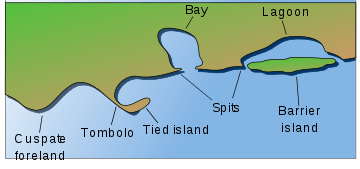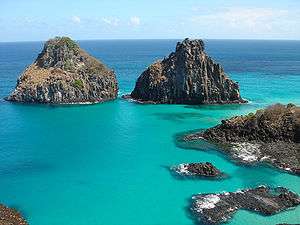Anchialine pool
An anchialine pool or pond (pronounced "AN-key-ah-line", from Greek ankhialos, "near the sea") is a landlocked body of water with a subterranean connection to the ocean. Anchialine pools are a feature of coastal aquifers which are density stratified, with the water near the surface being fresh or brackish, and saline water intruding from the coast below at some depth. Depending on the site, it is sometimes possible to access the deeper saline water directly in the anchialine pool, or sometimes it may be accessible by cave diving.[1]


Water levels in anchialine pools often fluctuate with tidal changes due to the coastal location and the connection with the ocean.[2] The range in water levels fluctuations will be decreased (damped) and delayed compared to the range and time observed for the adjacent tide. The primary controls on the damping and lag are the distance from the coast, and the hydraulic conductivity of the geological materials.
Anchialine pools are extremely common worldwide especially along Neotropical coastlines where the geology and aquifer system are relatively young, and there is minimal soil development. Such conditions occur notably where the bedrock is limestone or recently formed volcanic lava. Many anchialine pools are found on the coastlines of the island of Hawaii, and on the Yucatán Peninsula, where they are locally called cenotes, as well as Christmas Island.[3] The Sailor's Hat crater created by an explosives test in 1965 is an anchialine pool.[4]
Ecological studies of anchialine pools frequently identify regionally rare and sometimes endemic species. In Hawaii, the pools are home to the ʻōpaeʻula (Hawaiian shrimp, Halocaridina rubra). In karst anchialine pools and the caves that these may be connected to, the fauna are diverse and include crustaceans, including remipedia and copepods. Vertebrates are also found, including several species of blind cave fish.[5]
See also
References
- Bozanic, JE (1993). "Preliminary investigations in anchialine caves of Cuba". In: Heine and Crane (eds). Diving for Science...1993. Proceedings of the American Academy of Underwater Sciences (13th annual Scientific Diving Symposium). Archived from the original on 2012-05-09. Retrieved 2008-06-18.
- Especies marinas incluidas en el catálogo Español, in magrama.gob.es.
- Iliffe T, Humphreys W (2016). "Christmas Islands Hidden Secret". Advanced Diver Magazine. Retrieved 2016-01-02.
- Brock, Richard E.; Bailey-Brock, Julie H. (1998). "An Unique Anchialine Pool in the Hawaiian Islands". International Review of Hydrobiology. 83: 65. doi:10.1002/iroh.19980830107.
- Romero, A., editor (2001). The Biology of Hypogean Fishes. Developments in Environmental Biology of Fishes. ISBN 978-1402000768
External links
| Wikimedia Commons has media related to Anchialine pools. |
- Anchialine Pool Information United States Geological Survey, National Park Service 2005
- Anchialine Caves and Cave Fauna of the World

